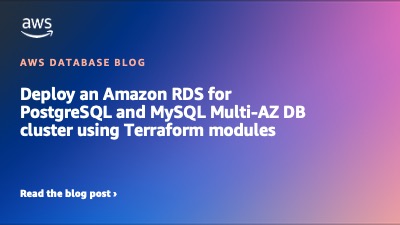AWS Database Blog
Category: Amazon RDS
Configure Multi-AZ with Amazon RDS Custom for SQL Server
Amazon Relational Database Service (Amazon RDS) Custom for SQL Server now supports high availability by using block-level replication in a Multi-AZ environment. Previously, to enable high availability on the instance, you had to configure an Always On Availability Group (AG) between two instances. Setting up and configuring Always On requires planning and expertise. With the […]
Integrate Amazon RDS for Oracle with Amazon EFS – Part 2 – Strengthen Access using EFS file system policy and Enforce in-transit encryption
With the announcement that Amazon Relational Database Service (Amazon RDS) for Oracle now supports integration with Amazon Elastic File System (Amazon EFS), you can keep temporary files like Oracle Data Pump export, import files on Amazon EFS file system, and directly access from it. Furthermore, you can leverage Amazon EFS integration for sharing a file system between […]
Amazon Aurora PostgreSQL database authorization using role-based access control
Many customers are using Amazon Aurora PostgreSQL-Compatible Edition for running their business-critical database workloads in AWS. Aurora PostgreSQL is a fully managed, PostgreSQL-compatible, and ACID-compliant relational database engine that combines the speed, reliability, and manageability of Amazon Aurora with the simplicity and cost-effectiveness of open-source databases. In this post, we present a database authorization solution […]
AWS Optimization and Licensing Assessments can help you to optimize Amazon RDS migration and usage costs
Oracle and Microsoft customers have been deploying their database workloads to Amazon Web Services in record numbers. The AWS Optimization and Licensing Assessment (AWS OLA) has helped many of these customers save on third party licensing costs and run their database resources efficiently on Amazon Elastic Compute Cloud (Amazon EC2) and VMware Cloud on AWS […]
Migrate Oracle Databases to AWS using transportable tablespace
Administering databases in self-managed environments such as on premises or Amazon Elastic Compute Cloud (Amazon EC2) requires you to spend time and resources on database administration tasks such as provisioning, scaling, patching, backups, and configuring for high availability. Organizations are moving their self-managed Oracle databases to AWS managed database services to offload undifferentiated heavy lifting […]
Improve query performance using Optimized Reads on Amazon RDS for MySQL and Amazon RDS for MariaDB
Amazon Relational Database Service (Amazon RDS) makes it easy to set up, operate, and scale MySQL and MariaDB deployments in the cloud. Developers are often required to run complex queries in MySQL and MariaDB environments to create a dashboard or run simple ad hoc reports. Furthermore, application developers use complex stored procedures with user-created temporary […]
Client-side T-SQL assessment for SQL Server to Babelfish for Aurora PostgreSQL migration
Babelfish for Aurora PostgreSQL is a capability for Amazon Aurora PostgreSQL-Compatible Edition that adds an endpoint to PostgreSQL that understands the SQL Server wire protocol Tabular Data Stream (TDS), as well as commonly used T-SQL statements from client applications written for Microsoft SQL Server. Migrating from legacy SQL Server databases can be time-consuming and resource-intensive. […]
Monitor Amazon RDS for PostgreSQL and Amazon Aurora PostgreSQL performance using PGSnapper
Collecting database performance metrics is critical for troubleshooting any performance issues. AWS offers several services to gather and analyze database performance metrics, including Amazon Relational Database Service (Amazon RDS) Enhanced Monitoring, Amazon CloudWatch, and Amazon RDS Performance Insights. While these services provide detailed insights on how your database is performing, sometimes you need a different […]
Choose the right PostgreSQL data access pattern for your SaaS application
In a multi-tenant environment, the process of identifying the database isolation strategy most suitable for your workload is essential. Your isolation strategy ensures that one tenant cannot access another tenant’s data, and defines how the actions of tenants affect one another. The isolation strategy is driven by a combination of business, domain, security, cost, resiliency, […]
Deploy an Amazon RDS for PostgreSQL and MySQL Multi-AZ DB cluster using Terraform modules
Selecting the right cloud management tool is extremely important for many enterprises. In the post 5 Tips for Keeping Pace with AWS’s Innovation, we briefly discussed the high-level strategies to overcome the challenges of continuous improvement and drive innovations in your organization. In this post, we show how infrastructure as code (IaC) solutions built with […]









